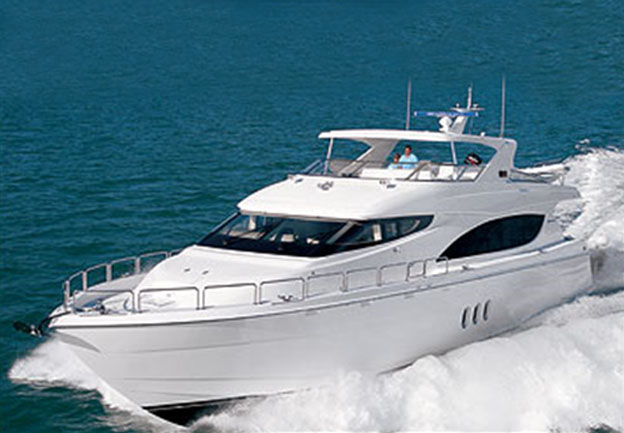- Alaskan Yachts
- Azimut Yachts
- Back Cove Yachts
- Beneteau Yachts
- Benetti Superyachts
- Bertram Yachts
- Boston Whaler
- Broward Yachts
- Buddy Davis Sportfish
- Burger Yachts
- Cabo Yachts
- Catamarans
- Carver Motoryachts
- Center Console
- Chris-Craft Yachts
- Cruisers Yachts
- DeFever Trawlers
- Dufour Sailboats
- Fairline Yachts
- Feadship Yachts
- Ferretti Yachts
- Formula Yachts
- Fountaine Pajot Cats
- Grady-White
- Grand Banks Trawlers
- Hargrave Yachts
- Hatteras Yachts
- Hinckley Picnic Boats
- Horizon Yachts
- Hydra-Sports
- Intrepid Boats
- Jarrett Bay Sportfish
- Jeanneau Yachts
- Kadey-Krogen Trawlers
- Lazzara Yachts
- Luhrs Sportfish
- Marlow Yachts
- Maritimo Yachts
- Marquis Yachts
- McKinna Motoryachts
- Meridian Yachts
- Midnight Express
- MJM Yachts
- Mochi Craft
- Neptunus Motoryachts
- Nordhavn Trawlers
- Nordic Tugs
- Ocean Alexander Yachts
- Offshore Yachts
- Outer Reef
- Oyster Sailing Yachts
- Pacific Mariner Yachts
- Palmer Johnson Yachts
- Pershing Yachts
80 Hatteras 2004
![]()

Source: Capt. Ken Kreisler, Power & Motoryacht Magazine
Let me float a nautical conundrum past your bow. Imagine you’re the owner off a 70-something-footer and want to move up to something bigger yet still manageable by a couple. Now imagine instead that you own a 120-footer and would like something smaller, yet with all the megayacht-class amenities you’re used to.
In both cases, your solution is a yacht in the 80-foot range, but which of the many boats in that size, built by quality yards with solid reputations both here and abroad, could make you happy? After spending two days aboard the Hatteras 80, I suggest that she’s a perfect candidate. With a generous 21’3” beam, she has the kind of space and features that both upsizing and downsizing boaters are looking for.
I first saw the 80 during her debut at last year’s Fort Lauderdale International Boat Show, and a few months later I was invited to accompany Capt. Terry Stansel on her passage from Lauderdale’s Pier 66 Marina to the Ocean Reef Club in Key Largo. Stansel usually doesn’t skipper 80-foot motoryachts. He’s Hatteras’ fishing captain and, more often than not, lives aboard the 54-foot company convertible Hatterascal on what can be a grueling 305-day-a-year tournament and boat show schedule. As the regular Hatteras motoryacht captains were busy, he got the call.
It turned out that the 80 was nearly as new to Stansel as she was to me. “Ken,” he said when I arrived, “looks like you and me both have to get used to this rig.” Considering we were both novices with her, Stansel and I looked over her operating features so that when we did let go the lines, we’d avoid any “monkey moves,” those embarassing situations when, out of ignorance, people start jumping around aimlessly trying to head off trouble.
The first feature I happened upon that I thought would appeal to owners moving both up and down was the lower helm station. It makes you feel like you’re on a big boat, yet you feel completely in control. Seated in one of two comfortable, leather-covered pedestal helm seats, I had excellent views through the two-panel windshield, despite its heavily padded mullions. The second such impression came from the expansive helm array, including a PC-based system with an LCD touchscreen mounted in the center and flanked by a Northstar 952XW GPS/plotter and a closed-circuit TV. This is the kind of setup I’m used to finding on megayachts. The PC system was developed in-house by senior electrical engineer Walt Hucks, and it provides instantaneous screen switching at the touch of a finger.
After firing up the standard 1,550-hp Caterpillar C30s, I scrolled through several parameters and quickly gained access to a ton of information. I found visual and audible alarms for the mains, gensets, gears, high bilge water, a.c. power loss, and even smoke detectors. I also accessed operational data such as rpm, gph, load, and boost pressure. The log even gave me information on previous alarms and anomolous conditions, information that would be helpful in establishing an operational base line as well as indicating problematic trends. This is the kind of data any responsible boater would be interested in having.
Boat Specifications: 80 Hatteras 2004
Boat Type: Megayacht (> 80′)
Standard Power: 2/1,550-hp Caterpillar C30 diesel inboards
Optional Power: 2/1,800-hp MTU 16V 2000 diesel inboards
Length Overall (LOA): 79’10”
Beam: 21’3”
Draft: 5’4”
Weight: 189,000 lbs.
Fuel Capacity: 2,158 gal.
Water Capacity: 326 gal.
Standard Equipment: 4,000-lb. Maxwell VWC windlass; 2/remote-controlled searchlights; central vacuum; 1,500-lb. Marquipt hydraulic davit; 1,200-gpd Sea Recovery watermaker; Glendinning cablemaster w/remote; 2/27.5-kW Onan gensets w/soundshields; PC touchscreen monitoring system, Northstar 952 GPS/plotter, ICOM VHF, Simrad AP20 autopilot and IS15 depth and speed indicators; flying bridge wet bar w/sink, refrigerator, ice maker, three stools, and Gaggenau grills w/cabinet; wing stations; 42-inch Sony plasma TV in saloon, Sound Surround, and DVD/CD player; 20-inch LCD TV, microwave/convection oven, sink, refrigerator, and head in crew’s quarters; 96,000-Btu Cruisair chilled-water A/C; 38-hp Naiad bow thruster
Test Engines: 2/1,550-hp Caterpillar C30 diesel inboards
Transmissions / Ratio: ZF 2560/5:1
Props: 50”x85” 7-blade Nibral
Steering: Teleflex Hynautic hydraulic-assisted
Controls: Sturdy electronic
Optional Equipment On Test Boat: Novurania 430-DL RIB w/60-hp Mercury four-stroke outboard; master stateroom w/dual heads; Pullman berth in port stateroom; 2/warping winches; saloon wine cooler; freshwater aft-deck washdown; third flying-bridge pedestal seat; washer/dryer combo in crew’s quarters
Conditions: temperature: 74º; humidity: 71%; wind: 10-15 mph; seas: calm; load: 1,200 gal. fuel, 300 gal. water, 5 persons, 1,000 lbs. gear. Speeds are two-way averages measured w/Stalker radar gun. GPH measured with Hatteras PC touchscreen monitoring system. Range: 90% of advertised fuel capacity. Decibels measured on A scale. 65 dB is the level of normal conversation. All measurements taken with trim tabs fully retracted.